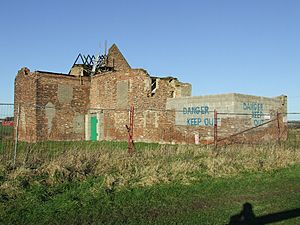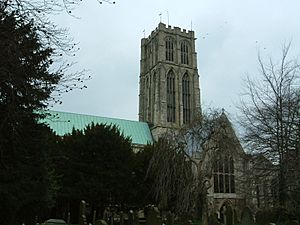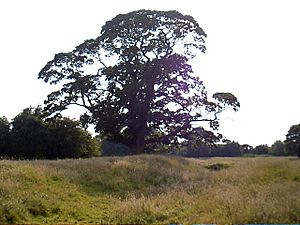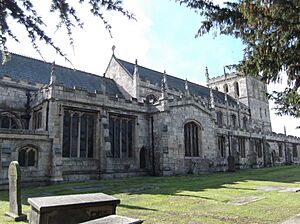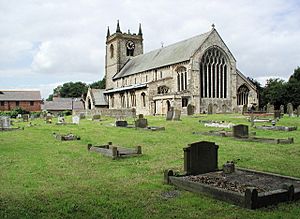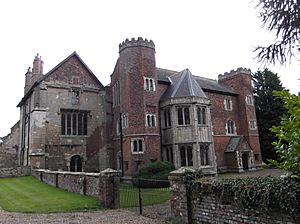List of monastic houses in the East Riding of Yorkshire facts for kids
Monastic houses were special places where groups of people, like monks, nuns, or friars, lived together under religious rules. These communities dedicated their lives to prayer, study, and work. In the past, these houses were very important centers for learning, charity, and even farming.
This article lists the different monastic houses that once existed in the East Riding of Yorkshire, England. You'll learn about when they were founded, who lived there, and what happened to them, especially during a time called the Dissolution, when many of these places were closed down.
Alien houses are included, as are smaller establishments such as cells and notable monastic granges (particularly those with resident monks), and also camerae of the military orders of monks (Knights Templars and Knights Hospitaller). Monastic hospitals are included where they had the status or function of an abbey, priory, friary or preceptor/commandery.
- Abbreviations and key
| Symbol | Status |
|---|---|
| None | Ruins |
| * | Current monastic function |
| + | Current non-monastic ecclesiastic function (including remains incorporated into later structure) |
| ^ | Current non-ecclesiastic function (including remains incorporated into later structure) or redundant intact structure |
| $ | Remains limited to earthworks etc. |
| # | No identifiable trace of the monastic foundation remains |
| ~ | Exact site of monastic foundation unknown |
| ≈ | Identification ambiguous or confused |
Locations with names in italics indicate possible duplication (misidentification with another location) or non-existent foundations (either erroneous reference or proposed foundation never implemented) or ecclesiastical establishments with a monastic name but lacking actual monastic connection.
| EH | English Heritage |
| LT | Landmark Trust |
| NT | National Trust |
Contents
- Monastic Houses in East Riding of Yorkshire
- Beverley Monastic Sites
- Bridlington Priory
- Burstall Priory
- Cottingham Priory
- Ellerton Priory
- Faxfleet Preceptory
- Haltemprice Priory
- Hemingbrough Minster
- Howden Minster
- Kingston upon Hull Monastic Sites
- Meaux Abbey
- North Ferriby Priory
- Nunburnholme Priory
- Nunkeeling Priory
- Ottringham Priory
- Snaith Priory
- Swine Priory
- Warter Priory
- Watton Priory
- Wilberfoss Priory
- Withernsea Priory
- Images for kids
- See also
Monastic Houses in East Riding of Yorkshire
This section lists the different monastic houses. Each entry tells you about the type of religious community that lived there, when it was founded, and what happened to it.
Beverley Monastic Sites
Beverley was home to several important religious communities.
- Beverley Minster
- This large church was first founded around 700 AD by John of Beverley, an Archbishop.
- It was a home for Benedictine monks and nuns, and also a "collegiate church," meaning it had a group of priests living together.
- After being destroyed by Viking raids around 867, it was rebuilt around 934.
- It was closed down in 1547.
- Beverley Blackfriars
- This was a home for Dominican Friars, also known as Blackfriars because of their dark robes.
- It was founded around 1267, possibly by Stephen Goldsmith.
- The friary was closed in 1539.
- Beverley Greyfriars
- This was a home for Franciscan Friars Minor, also called Greyfriars.
- Their first home was set up before 1267.
- They moved to a new site in 1297.
- The friary was closed in 1539.
- Beverley Preceptory
- This was a house for the Knights Hospitaller, a military religious order.
- It was founded around 1201.
- The preceptory was closed in 1540.
Bridlington Priory
- Bridlington Priory
- This priory was home to Augustinian Canons Regular.
- It was founded before 1114 by Walter de Gant.
- The priory was closed in 1537.
- Today, the main church building is still used as a local parish church.
Burstall Priory
- Birstall Priory
- This priory housed Benedictine monks.
- It was an "alien house," meaning it was controlled by a larger monastery in France (Aumale).
- Founded after 1115, it was sold in 1395.
- The site later disappeared under the Humber Estuary after 1540.
Cottingham Priory
- Cottingham Priory
- This priory was for Augustinian Canons Regular.
- It was founded in 1322 by Thomas Wake.
- The community moved to Haltemprice Priory between 1325 and 1326.
Ellerton Priory
- Ellerton Priory (Spalding Moor)
- This was a priory and hospital for Gilbertine Canons.
- It was founded before 1209 by William Fitz Peter.
- The priory was closed on December 18, 1538.
Faxfleet Preceptory
- Faxfleet Preceptory
- This was a house for the Knights Templar, another military religious order.
- It was founded in 1185.
- The preceptory was closed between 1308 and 1312.
- Today, a fortified manor house stands on its site.
Haltemprice Priory
- Haltemprice Priory
- This priory was for Augustinian Canons Regular.
- The community moved here from Cottingham in 1325–1326.
- It became an independent priory before 1355.
- The priory was closed on August 12, 1536.
Hemingbrough Minster
- Hemingbrough Minster
- This church was managed by Benedictine monks from Durham Cathedral.
- A license was given in 1426 to create a college of priests here.
- It was closed in 1547.
Howden Minster
- Howden Minster
- This was a "collegiate church," meaning it had a group of priests living together.
- It was founded in 1267 by Robert, Bishop of Durham.
- The college was closed in 1550.
Kingston upon Hull Monastic Sites
Kingston upon Hull also had several important monastic communities.
- Kingston upon Hull Austin Friars
- This house was for Augustinian Friars.
- It was founded before 1303.
- The friary was closed in 1539.
- Its remains were mostly demolished around 1796.
- Kingston upon Hull Greyfriars
- This was a house for Franciscan Friars Minor.
- It was founded after 1307.
- The friary was closed before 1365.
- A Carthusian Priory was later built on this site in 1377.
- Kingston upon Hull Whitefriars
- This house was for Carmelite Friars, also known as Whitefriars.
- Their first site was established between 1290 and 1293.
- They moved to a new site in 1307.
- The friary was closed in 1539.
- Kingston upon Hull Priory
- This priory was for Carthusian monks.
- It was founded in 1377.
- The priory was closed in 1539.
Meaux Abbey
- Meaux Abbey
- This was a Cistercian monastery, a "daughter house" of Fountains Abbey.
- It was founded in 1150 by William of Blois.
- The community of monks arrived on January 1, 1151.
- The abbey was closed on December 11, 1539.
- Today, a farm stands on its site.
North Ferriby Priory
- North Ferriby Priory
- This priory was for Augustinian Canons Regular.
- It was founded around 1140 by Eustace fitz John.
- The priory was closed between 1536 and 1537.
Nunburnholme Priory
- Nunburnholme Priory
- This priory was home to Benedictine nuns.
- It was founded possibly before 1170.
- The priory was closed in 1536.
Nunkeeling Priory
- Nunkeeling Priory
- This priory was for Benedictine nuns.
- It was founded in 1152 by Agnes de Arches.
- The priory was closed in 1539.
- Some remains are part of a ruined church built in 1810.
Ottringham Priory
- Ottringham Priory
- This was a Cistercian "chantry," a place where monks from Meaux Abbey lived and prayed.
- Monks lived at Ottringham church from 1293 to 1323.
Snaith Priory
- Snaith Priory
- This priory was for Benedictine monks.
- It was founded after 1101.
- Monks lived here from 1310.
- The priory was closed in 1539.
Swine Priory
- Swine Priory
- This was a "double house" for Cistercian nuns and possibly Premonstratensian canons.
- It was founded before 1153 by Robert de Verli.
- The male community might have changed to Trinitarian canons later.
- After 1335, it became a regular nunnery.
- The priory was closed on September 9, 1539.
- The church building is still used as a parish church today.
Warter Priory
- Warter Priory
- This priory was for Augustinian Canons Regular.
- It was first an "alien house" dependent on a French monastery, Arrouaise.
- It became independent in 1162.
- The priory was closed in 1536.
- The original church was demolished in 1864, and a new church was built on the site.
Watton Priory
- Watton Priory
- This priory was first for Benedictine nuns, founded around 686.
- It was likely destroyed by Viking raids in the 9th century.
- It was refounded in 1150 as a "double monastery" for Gilbertine Canons and nuns.
- The priory was closed in 1539.
- A house called 'Watton Abbey' now stands on the site.
Wilberfoss Priory
- Wilberfoss Priory
- This priory was for Benedictine nuns.
- It was founded around 1154 by Alan de Cotton and Jordan fitz Gilbert.
- The priory was closed in 1539.
- The current local church might be part of the original priory church.
Withernsea Priory
- Withernsea Priory
- This priory was for Benedictine monks.
- It was an "alien house" dependent on a French monastery, Aumale.
- Founded around 1115, it was later destroyed by the sea.
Images for kids
See also



